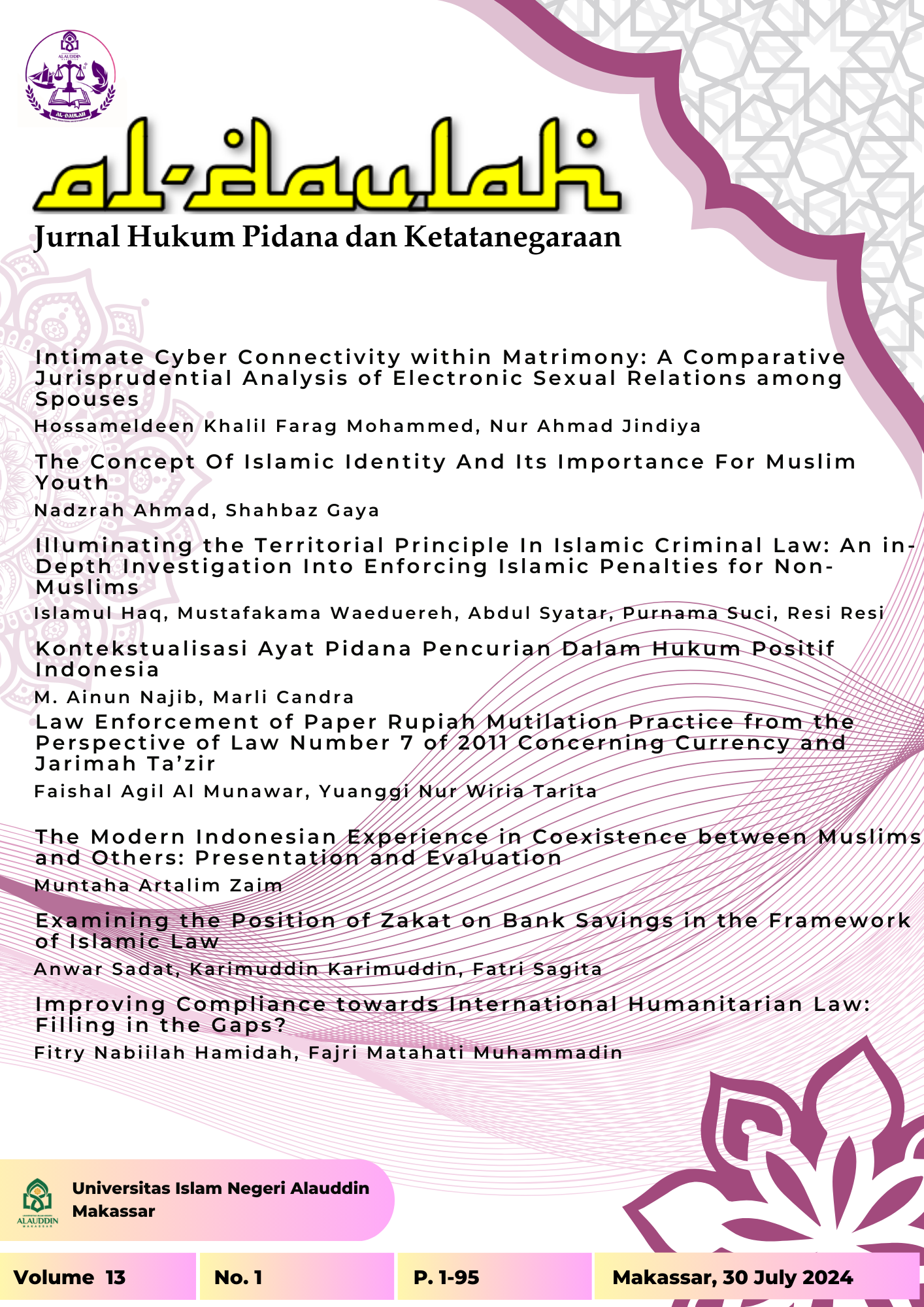MENAKAR KASUS PENYALAHGUNAAN NARKOBA OLEH KELOMPOK MAHASISWA FIB USU DENGAN TEORI-TEORI KRIMINOLOGI
Abstract
Tujuan dari penelitian ini adalah untuk mengetauhi sebab kelompok mahasiswa FIB USU dapat terjerumus kepada praktek penyalahgunaan narkoba dan bagaimana kasus tersebut dipahami melalui teori-teori kriminologi. Untuk mengetauhi hal tersebut peneliti melakukan penelitian dengan metode normatif. Teknik pengumpulan data dengan cara kajian dan riset kepustakaan. Hasil dari pengumpulan data kemudian dianalisis secara kualitatif dan dihubungkan dengan teori-teori kriminologi yang berkembang. Hasil dari penelitian ini menunjukan bahwa Social Learning, Labeling, Differential Association, dan Anomie /Strain Theory merupakan pendekatan yang kuat dan konsisten dari kemungkinan perilaku penggunaan narkoba mahasiswa. Analisis ini juga menjabarkan sebab penggunaan narkoba para mahasiswa FIB USU tersebut dengan teori modern tentang perilaku menyimpang (deviant) dalam perilaku penggunaan narkoba pelajar zaman sekarang. Sehingga diharapkan kedepannya para kriminolog menemukan pendekatan yang lebih interdisiplin untuk kasus penyalahgunaan narkoba pada generasi muda di masa depan.
References
AKERS, R. L. (1999). Social Learning and Social Structure: Theoretical Criminology, 3(4). https://doi.org/10.1177/1362480699003004007
Akers, R. L., & Sellers, C. S. (2011). Social Learning Theory. In The Oxford Handbook of Juvenile Crime and Juvenile Justice. https://doi.org/10.1093/oxfordhb/9780195385106.013.0014
Becker, H. S. (2018). Labelling theory reconsidered. In Deviance and Social Control. https://doi.org/10.4324/9781351059039-2
Collins, J. J., & Messerschmidt, P. M. (1993). Epidemiology of alcohol-related violence. Alcohol Health & Research World, 17(2), 93–100.
Edwin H. Sutherland. (1969). Azas-azas Kriminologi (VII). Alumni.
Ensminger, M. E., Anthony, J. C., & McCord, J. (1997). The inner city and drug use: Initial findings from an epidemiological study. Drug and Alcohol Dependence, 48(3). https://doi.org/10.1016/S0376-8716(97)00124-5
Fagan, J. (1993). Set and setting revisited: Influences of alcohol and illicit drugs on the social context of violent events. Alcohol and Interpersonal Violence: Fostering Multidisciplinary Perspectives, 24, 161–191.
Figueira-McDonough, J. (1992). Disorder and Decline: Crime and the Spiral of Decay in American Neighborhoods . Wesley G. Skogan . Social Service Review, 66(2). https://doi.org/10.1086/603921
Gorman, D. M. (1996). Etiological theories and the primary prevention of drug use. In Journal of Drug Issues (Vol. 26, Issue 2). https://doi.org/10.1177/002204269602600210
Hayes, K. (1986). Modern criminology: Crime, criminal behavior, and its control. Journal of Criminal Justice, 14(1). https://doi.org/10.1016/0047-2352(86)90040-1
Khantzian, E. J. (1985). The self medication hypothesis of addictive disorders: Focus on heroin and cocaine dependence. In American Journal of Psychiatry (Vol. 142, Issue 11). https://doi.org/10.1176/ajp.142.11.1259
Lemert, E. M. (2015). Labeling Theory Secondary Deviance (Criminolog). Routledge.
Lusia Sinta Herindrasti, V. (2018). Drug-free ASEAN 2025: Tantangan Indonesia dalam Penanggulangan Penyalahgunaan Narkoba. Jurnal Hubungan Internasional, 7(1). https://doi.org/10.18196/hi.71122
Mitchell Miller, J., & Miller, H. V. (2014). Sociological criminology and drug use: A review of leading theories. In The Nurture Versus Biosocial Debate in Criminology: On the Origins of Criminal Behavior and Criminality. https://doi.org/10.4135/9781483349114.n19
Okada, D. (2015). Criminological Theory and Crime Explanation. Criminal Justice and Criminological Paradigms.
Pedalono, J., & Frailing, K. (2018). General Strain Theory and Prescription Drug Misuse among Honors Students. Journal of the National Collegiate Honors Council, 19(1).
Sampson, R. J., Raudenbush, S. W., & Earls, F. (1997). Neighborhoods and violent crime: A multilevel study of collective efficacy. Science, 277(5328). https://doi.org/10.1126/science.277.5328.918
SMUSHKIN, A. B. (2019). PRINCIPLES OF CRIMINOLOGY. Actual Problems of Russian Law, 5. https://doi.org/10.17803/1994-1471.2019.102.5.159-168
White, H. R. (1990). The drug use-delinquency connection in adolescence. In 1990 (pp. 215–256). Anderson Publishing Co.
White, H. R., Brick, J., & Hansell, S. (1993). A longitudinal investigation of alcohol use and aggression in adolescence. Journal of Studies on Alcohol, 54(SUPPL. 11). https://doi.org/10.15288/jsas.1993.s11.62
Williams III, F. P., & McShane, M. D. (1988). Criminological theory. New Jerseyn Printice Hall.
World Drug Report 2012. USA: United Nations Office On Drugs And Crime; 2012. Available from: http://www.unodc.org/unodc/en/data-and-analysis/WDR-2012.html, diakses pada hari Senin (25/09/21) pada pukul 07.31 WIT
https://www.beritasatu.com/nasional/792291/27-pengguna-narkoba-dari-kalangan-pelajar-dan-mahasiswa, diakses pada hari Senin (25/09/21) pada pukul 10.00 WIT
https://puslitdatin.bnn.go.id/portfolio/data-statistik-kasus-narkoba/, diakses pada hari Senin (25/09/21) pada pukul 10.42 WIT
https://www.realitarakyat.com/2021/10/sebanyak-47-orang-di-usu-diangkut-bnn-sumut-karena-terlibat-narkoba/?print=pdf, diakses pada hari Senin (25/09/21) pada pukul 11.02 WIT
https://regional.kompas.com/read/2021/10/11/192716378/kronologi-bnn-gerebek-fib-usu-3-pengedar-ganja-ditangkap-31-orang-positif?page=all, diakses pada hari Senin (25/09/21) pada pukul 11.08 WIT
https://soztheo.de/theories-of-crime/anomie-strain-theories/?lang=en, diakses pada hari Rabu (27/09/21) pada pukul 10.49 WIT
The authors of a work hold the copyright and grant the Al-Daulah: Jurnal Hukum Pidana dan Ketatanegaraan the right of first publication. The work is also licensed under the Creative Commons Attribution License (CC BY 4.0), which enables others to share the work while acknowledging the authorship and initial publication in the journal. The authors can make separate contractual agreements for the non-exclusive distribution of the published version of the work, such as by posting it to an institutional repository or editing it for a book, with an acknowledgment of its initial publication in this journal. Authors are allowed and encouraged to post their work online, such as in institutional repositories or on their website, before and during the submission process. This can lead to productive exchanges and greater citation of the published work.


